Data extracted in January 2024
Planned article update: January 2027
Highlights
Tourists aged 65 years and over accounted for nearly 1 in 4 tourism nights for private purposes spent by EU residents in 2022.
More than half of European residents aged 65 years and over did not participate in tourism in 2022, compared with 33 % of persons aged 15-64 years.
Senior tourists make longer trips, preferably in their country of residence and stay at non-rented accommodation.
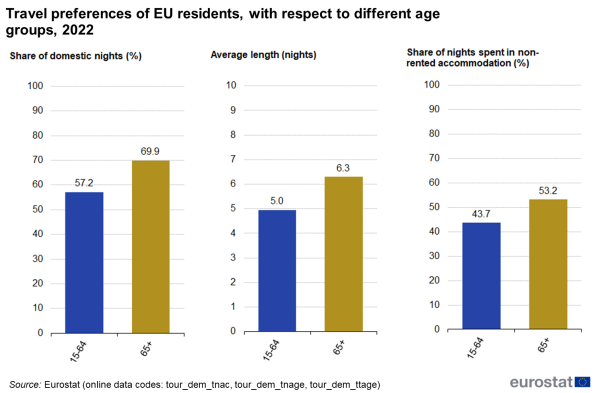
Source: Eurostat (tour_dem_tnac) (tour_dem_tnage) (tour_dem_ttage)
This article looks at the relationship between age and tourism behaviour, focusing on senior citizens. European statistics on trips of EU residents , the main source of data for this article, cover trips for personal and for professional reasons. Since this article focuses on comparing senior citizens with the rest of the population, only trips for personal purposes are considered for this publication (data shows indeed that only 2 % of trips made by EU residents aged 65 years and over were for professional purposes, while in the other age groups business trips accounted for 11 % of all tourism trips made). The article analyses tourism preferences of senior citizens in terms of destination, period of travel, length of stay, type of accommodation used and expenditure habits during trips. The data refers to the year 2022, unless footnoted differently.
Does retirement boost travel?
Tourists aged 65 years and over accounted for nearly 1 in 4 (24 %) tourism nights for private purposes spent by EU residents aged 15 years and over (see Figure 1). This figure was close to this age group's share in the population aged 15 years and over (25 %).
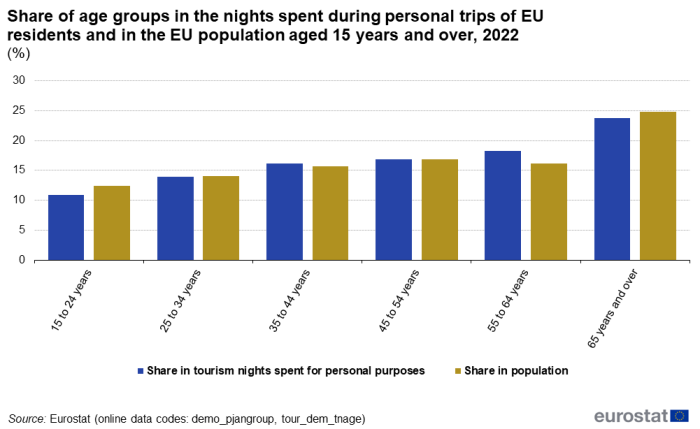
Source: Eurostat (demo_pjangroup) (tour_dem_tnage)
Figure 2 shows the share of each age category in the total number of tourism trips and nights and in the total population aged 15 years and over. The differences between the share of tourism and of the population until the age of 65 years were relatively small. In other words tourism behaviour was not affected significantly by age. However, people between the ages of 65 and 70 years travelled more intensively, making longer trips — probably because of the available time following retirement.
Looking at the population groups in greater detail, we see that people aged 60-74 years generated 23 % of trips and 26 % of tourism nights for private purposes but represented 21 % of the population aged 15 years and over. On the other hand people aged 75 years and over generated 5 % of trips and 7 % of tourism nights for private purposes although this group represented 12 % of the population aged 15 years and over. People over 75 years tended to travel less (in relation to their share of the population) — possibly due to a decreasing motivation to travel or to health issues.
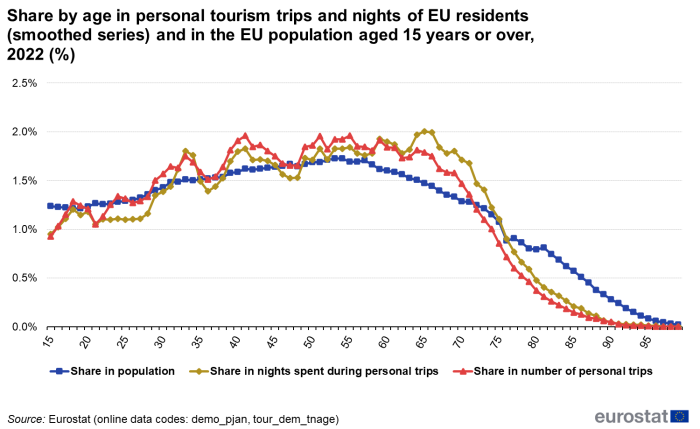
Source: Eurostat (demo_pjan) (tour_dem_tnage)
Older people participate less in tourism
Table 1 shows that 18 % of the total number of EU residents who participated in tourism in 2022 were aged 65 years and over while this age group represents 25 % of the total population aged 15 years and over. The share of each of the other age groups in the tourist population was at least equal or higher to the share of the respective group in the total population, except the age group from 15 to 24 years.
However, there were major differences between countries. In Sweden the share of the age group 65 years and over in the tourist population (28 %) was higher than the share of this age group in the total population (25 %). On the other hand, in Bulgaria and Croatia this age group amounted to less than 10 % of that country's tourist population, while people aged 65 years and over made up respectively 25 % and 26 % of the total 15 years and over population.
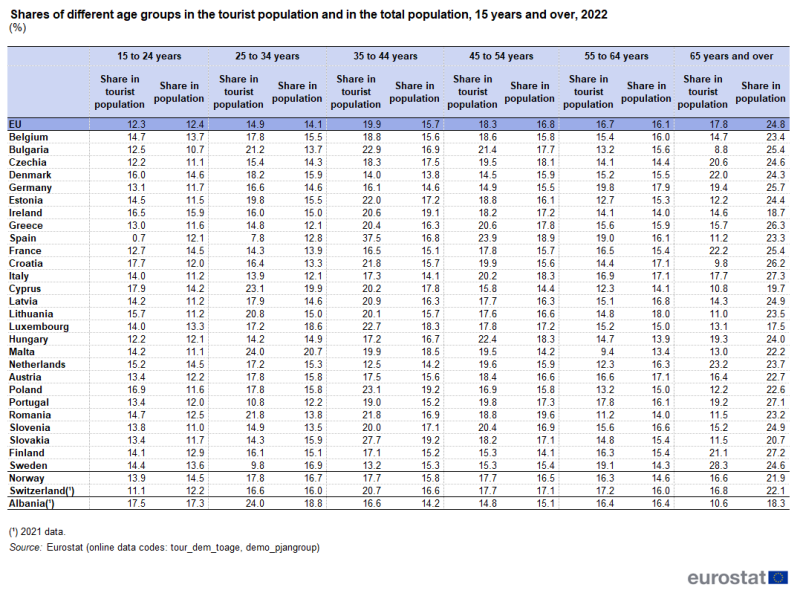
Source: Eurostat (tour_dem_toage) (demo_pjangroup)
In 2022, 38 % of the EU residents aged 15 and over did not participate in tourism, which means that they did not make any trip for personal purposes with at least one night away from home. Looking at age groups, more than half (55 %) of people aged 65 years and over did not undertake any trip (see Figure 3); this is by far the highest proportion of people not participating in tourism in any age group. Among the rest of the population (people aged 15-64 years), only 33 % on average did not make any trips. Furthermore, more than half of the tourists aged 15-64 years (51 %) only made domestic trips, while this share was much higher for the tourists aged 65 years and over (62 %).
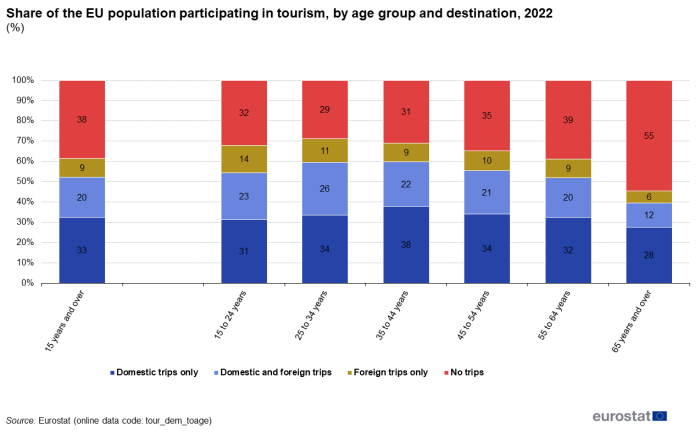
Source: Eurostat (tour_dem_toage)

Source: Eurostat (tour_dem_toage)
Table 2 shows that in all Member States the share of older people not participating in tourism was higher than the share of the general population aged 15 years and over not participating in tourism.
There were still major discrepancies between countries. The Netherlands had the lowest general non-participation rate (only 16 % of the population aged 15 years and over did not engage in tourism), followed by Luxembourg and Finland (with 17 % and 19 % respectively). These 3 countries, together with France, also recorded the lowest rates of older people aged 65 years and over not participating in tourism, with 28 % in the Netherlands and France, followed by Luxembourg (32 %) and Finland (33 %). It should be mentioned here that Norway had even lower shares, with only 11 % of the population aged 15 years and over and 17 % of people aged 65 years and over not participating in tourism.
On the other hand, Bulgaria and Romania had the highest general non-participation rates (both with 72 % of the population aged 15 years and over), while the share of people aged 65 years and over not making any trips was respectively 89 % and 86 %.
Two out of five Europeans aged 65 years and over who do not make tourism trips mention health reasons
Europeans aged 65 years and over had very different reasons not to travel compared with other age groups. 41 % gave health as one of the main reasons, and this was the most frequently cited reason (see Figure 4). Among the rest of the population (aged 15 to 64 years), only 9 % cited health.
Two out of five (44 %) Europeans aged 15-64 years who did not make tourism trips mentioned financial reasons, while only one out of four (28 %) persons aged 65years and over cited financial considerations as a reason for not travelling.
Furthermore, 34 % of persons aged 65 years and over showed no interest in travelling, while in the 15-64 age group, this figure was 20 %.
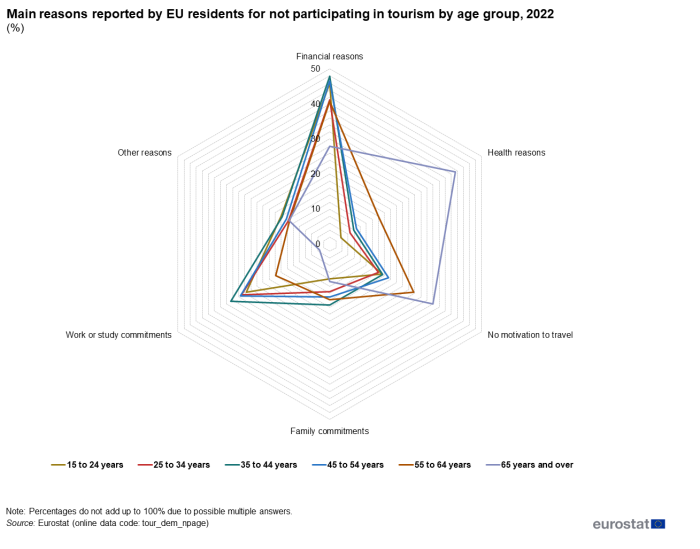
Source: Eurostat (tour_dem_npage)
This disparity was mirrored at national level. In Table 3, the most frequently cited reason for not travelling is highlighted for each country and for each age group (15-64 years and 65 years and over). Looking at the 15-64 years age group, in 23 of the 27 EU Member States, financial reasons were mentioned most frequently. Among people aged 65 years and over, health reasons were the most commonly stated reason in 19 out of the 27 Member States, followed by no interest to travel in five Member States and financial reasons in the remaining three Member States.
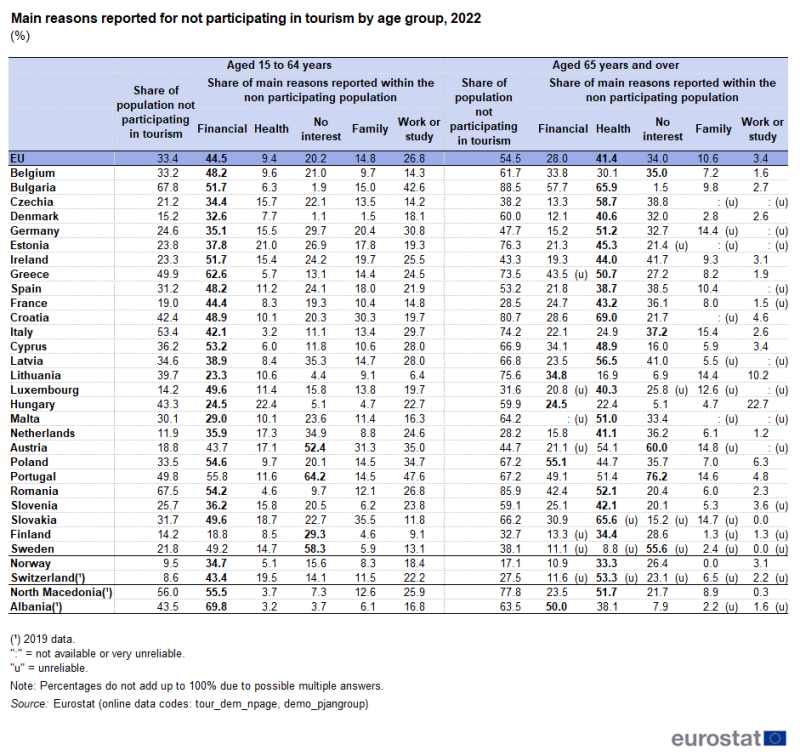
Source: Eurostat (tour_dem_npage) (demo_pjangroup)
Seasonal patterns
In order to observe how the seasonal patterns of travel habits change with age, this chapter compares the distribution of nights spent by the two age groups 15-64 years and 65 years and over over the year.
Figure 5 shows that younger people tend to travel during school holidays and were therefore overrepresented in the summer season, while older people travelled more in the 'shoulder season', i.e. the travel period between peak and off-peak seasons, with a less pronounced summer peak. The difference between 65 years and over and the younger age groups was most pronounced just before summer (May, June) or autumn (September, October, November), meaning older tourists are extending the peak tourism season.
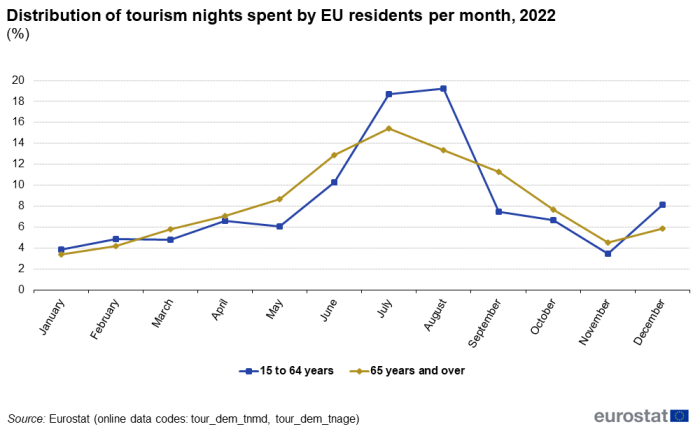
Source: Eurostat (tour_dem_tnmd) (tour_dem_tnage)
The peak season, the shoulder season and the winter season for the two age groups are now analysed using pie charts. As shown before, for people aged 65 years and over, the shoulder season was much more pronounced (more than half of all nights were spent during this time) than the typical peak season (29 % of their tourism nights were spent in July or August) (see Figure 6).
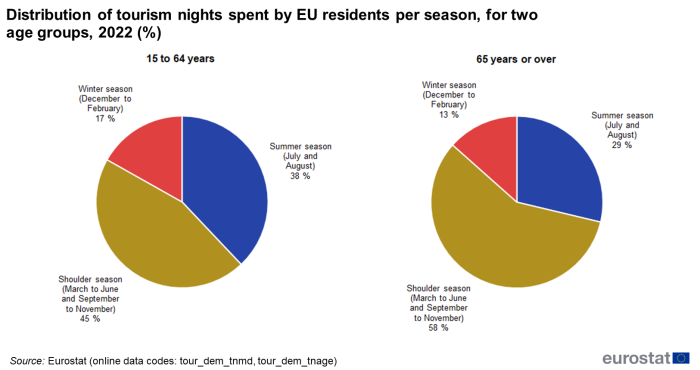
Source: Eurostat (tour_dem_tnmd) (tour_dem_tnage)
Travel preferences and expenditure of tourists aged 65 years and over
Within the trips for personal purposes, the share of trips for leisure, holidays and recreation was lower for senior travellers, while the other two categories "visiting friends and relatives" and "other personal trips" (including trips relating to health treatment) were higher (see Figure 7).

Source: Eurostat (tour_dem_ttpur) (tour_dem_ttage)
Tourists aged 65 years and over were more likely to make longer tourism trips, trips within their country of residence (domestic trips) and trips spent at non-rented accommodation, for instance at holiday homes they owned or visiting relatives and friends (see Figure 8).
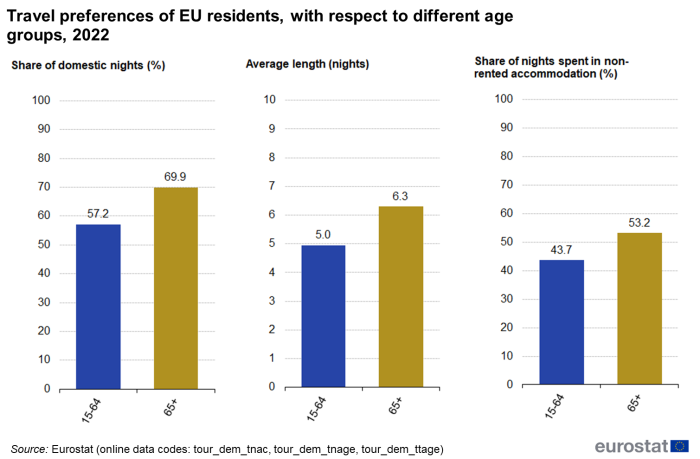
Source: Eurostat (tour_dem_tnac) (tour_dem_tnage) (tour_dem_ttage)
These findings were mirrored at national level as can be seen in Table 4. The overall conclusions at EU level are the same for most Member States.
The share of domestic nights was higher for people aged 65 years and over than for people aged 15-64 years in most EU countries. Only in Bulgaria, Estonia and Luxembourg the share of domestic nights was lower for senior tourists compared with the other age groups.
EU residents aged 65 years and over made on average longer trips than people aged 15-64 years, with the exception of Lithuania and Hungary. Furthermore, the older age group spent more nights in non-rented accommodation when compared with the younger age groups except for Germany and Austria.

Source: Eurostat (tour_dem_tnac) (tour_dem_tnage) (tour_dem_ttage)
The above findings are significant when you consider the expenditure per night of people aged 65 years and over, since older tourists spent less on transport and on accommodation as domestic holidays and non-rented accommodation are generally cheaper.
On average, i.e. regardless of the type of the trip, tourists aged 65 years and over spent less. Figure 9 shows that people aged 65 years and over accounted for 24 % of all nights spent by Europeans, but their share of tourism expenditure was 20 %. This can partially be explained by the travel habits of older tourists outlined in the previous paragraph.
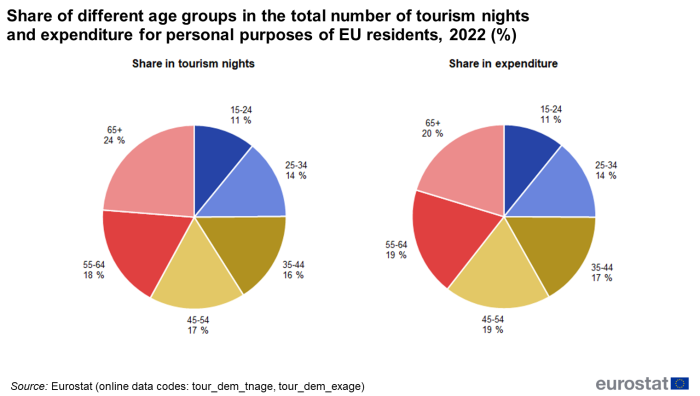
Source: Eurostat (tour_dem_tnage) (tour_dem_exage)
Figures 10a to 10d look at groups of trips that are similar in nature in order to reduce the structural effects of the trip's characteristics. In other words: do senior tourists show different expenditure habits when considering comparable types of trips?
Figure 10a shows the overall difference regardless of the type of trip: on average older residents spent less all year round (-18 %). However, when taking into account the observations on the travel preferences highlighted above (see Figure 8) and looking at the differences in spending between age groups for similar types of trips, the effect is far less pronounced.
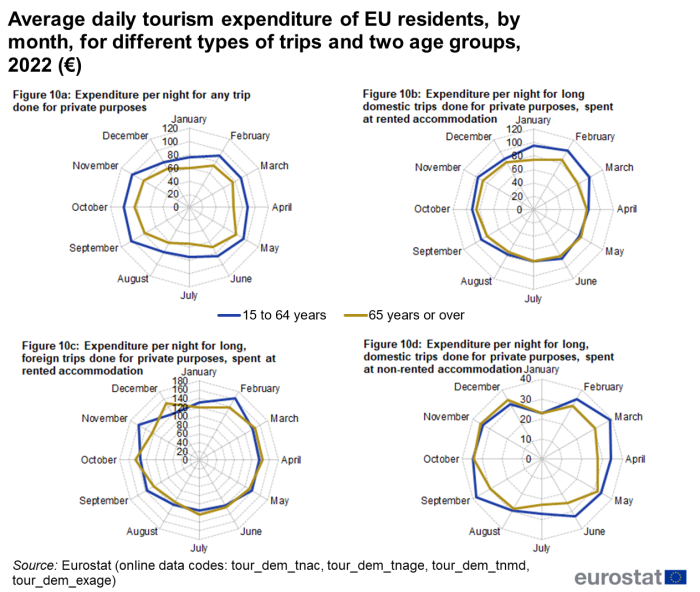
Source: Eurostat (tour_dem_tnac) (tour_dem_tnage) (tour_dem_tnmd) (tour_dem_exage)
Figures 10b to 10d show the difference in expenditure for the three most popular types of trips that accounted for more than two thirds of all nights spent by EU residents. During long domestic trips spent at rented accommodation, the average daily expenditure of persons aged 65 years and over was 5 % lower than the expenditure of people aged 15-64 years (Figure 10b), while for similar foreign trips (Figure 10c) the average expenditure was higher for senior tourists (+1 %).
However, when looking at long domestic trips spent in non-rented accommodation, Figure 10d shows that the average daily expenditure of people aged 65 years and over was 10 % lower than that of people aged 15-64 years.
Source data for tables and graphs
Data sources
Collection of annual data on trips of EU residents
The collection consists of harmonised data collected by the Member States in the frame of the Regulation 692/2011 of the European Parliament and of the Council concerning European statistics on tourism.
The data come from household surveys carried out by the national statistics authorities in the Member States. Data are collected partly using questionnaires to gather information on trips made, the purpose of the trip, the destination, the main means of transport, the type of accommodation and expenditure. Information is also collected on the month of departure and the age of the traveller.
Context
The EU is a major tourist destination, with four Member States among the world’s top ten destinations for holidaymakers, according to UNWTO[1] data. Tourism is an important activity in the EU which has the potential to contribute towards employment and economic growth, as well as to development in rural, peripheral or less-developed areas. These characteristics drive the demand for reliable and harmonised statistics within this field, as well as within the wider context of regional policy and sustainable development policy areas.
Footnotes
Explore further
Other articles
- News release on ageing and tourism at the occasion of the 2016 World Tourism Day
- Tourism trips of Europeans (online publication)
- All articles on tourism statistics
Database
- Tourism (tour), see:
- Trips of EU residents - annual data (tour_dem)
Thematic section
Publications
Selected datasets
- Tourism (t_tour), see:
- Annual data on trips of EU residents (t_tour_dem)
Methodology
- Trips of EU residents - annual data (ESMS metadata file — tour_dem)
External links
- Agenda for a sustainable and competitive European tourism (Communication from the European Commission, October 2007)
- European Commission - Directorate-General for Internal Market, Industry, Entrepreneurship and SMEs - Tourism
- Virtual Tourism Observatory
Legislation
- With 2012 as reference year:
- Regulation (EU) No 692/2011 of 6 July 2011 concerning European statistics on tourism and repealing Council Directive 95/57/EC.
- Summaries of EU Legislation: Tourism statistics
- Regulation (EU) No 1051/2011 of 20 October 2011 implementing Regulation (EU) No 692/2011 concerning European statistics on tourism, as regards the structure of the quality reports and the transmission of the data.
